http://e-info.org.tw/node/114890
白化來襲!大堡礁93%礁體白化 西澳珊瑚也遭殃
文字大小
459 3 Share1
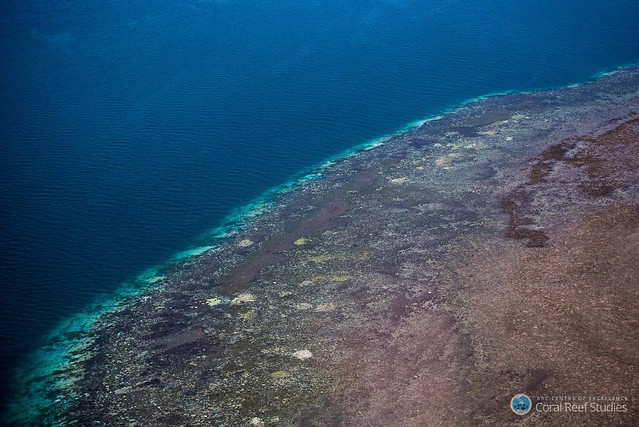
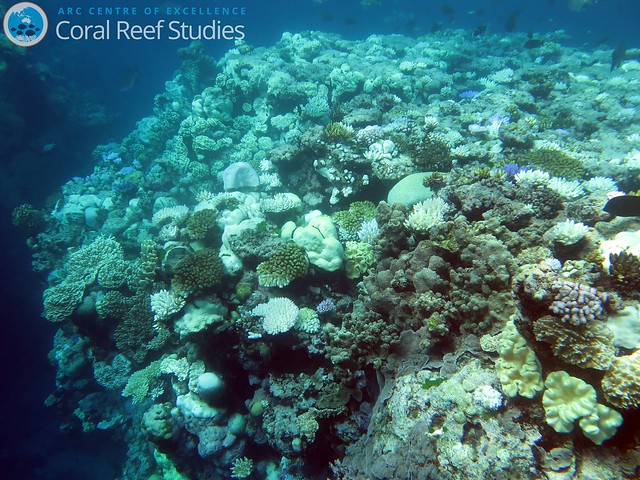
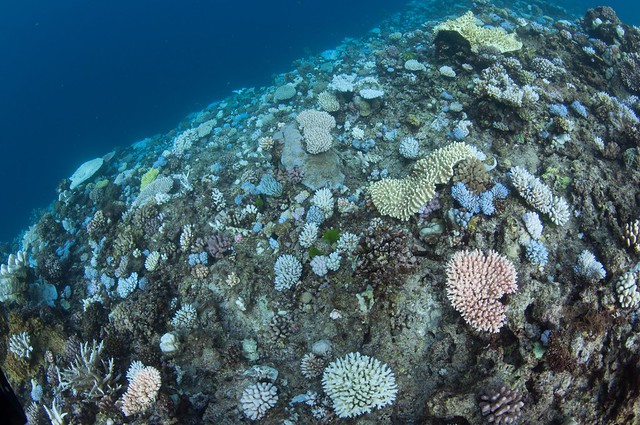
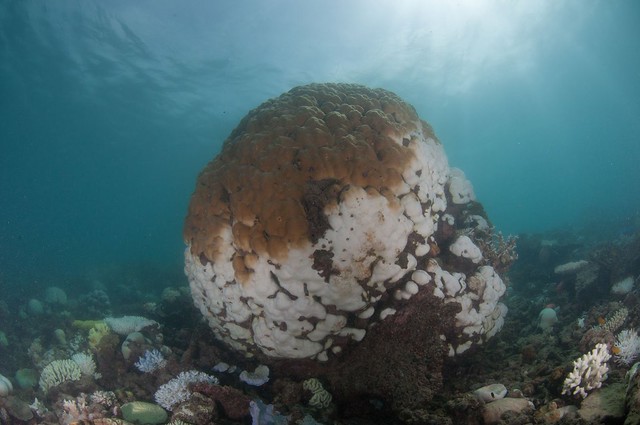
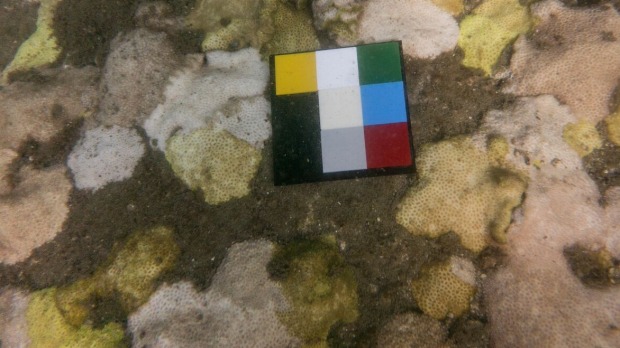
作者:馮加伶(社團法人台灣海洋環境教育推廣協會)、郭兆揚(澳洲詹姆斯庫克大學,ARC珊瑚礁卓越研究中心)
位於澳洲東北部的大堡礁,是所有愛海人士心中的海洋天堂,在這裡有超過2900個獨立珊瑚礁體、900個珊瑚礁小島,總面積超過34萬平方公里(相當於9.5個台灣),為全世界最大最長的珊瑚礁群,也是全球著名的海洋保護區。色彩繽紛的珊瑚礁、豐富多樣的珊瑚礁魚和貝類,吸引許多人前來朝聖,每年的觀光產值可達30億美元(相當於960億台幣),是澳洲昆士蘭省重要的經濟來源。
什麼!大堡礁珊瑚白化了!
自從美國國家海洋暨大氣管理局(NOAA)在2015年警告全球暖化可能帶來自1998和2002年之後的第三波全球珊瑚白化潮,由位於詹姆斯庫克大學(James Cook University)的ARC珊瑚礁卓越研究中心(ARC Centre of Excellence for Coral Reef Studies)的中心主任休斯(Terry Hughes)教授為召集人,集合澳洲10個研究機構與學校單位,超過300位科學家組成澳洲國家珊瑚白化工作團隊(Australia's National Coral Bleaching Taskforce),對可能發生的大堡礁珊瑚白化事件嚴陣以待。
3月是澳洲的盛夏高峰,從2016年3月初開始,大堡礁就有零星的白化現象出現,3月中之後則提升為大規模的白化事件,這個消息讓許多愛海人士心碎不已,其心慌心痛的程度並不亞於日本偶像結婚導致粉絲無法工作而請假的花邊新聞。

2016年大堡礁珊瑚白化調查空拍照,珊瑚礁的邊緣和其中的白色斑塊,都是白化的珊瑚。圖片出處:ARC Centre of Excellence for Coral Reef Studies。
修斯教授與團隊的專案經理凱瑞(James Kerry)為了瞭解大堡礁珊瑚礁白化的程度與範圍,隨即搭乘直升機和輕航機進行空拍調查從大堡礁南端往北到巴布亞紐幾內亞(Papua New Guinea)約2300公里長的海域。調查持續至今,飛行總距離超過9,000公里,檢視超過911座珊瑚礁體,其中只有7%(68個)的礁體躲過一劫,其餘93%的礁體都受到不同程度的白化事件影響,絕大多數的珊瑚礁(316座)都因為有60-100%的珊瑚發生白化,而被評為「嚴重白化」。
註:珊瑚白化:因海水溫度改變、水質、污染等因素,讓珊瑚及其體內的共生藻感到壓力,導致共生藻死亡或是離開珊瑚蟲,僅剩下透明的珊瑚蟲與白色骨骼的現象,稱作『珊瑚白化』。珊瑚絕大部分的營養來源都是由共生藻所供給,如果珊瑚白化的時間持續過久,珊瑚就會因饑餓而導致死亡。
影片:2016年大堡礁珊瑚白化調查影片,從空中俯瞰嚴重白化的北段大堡礁。影片來源:ARC Centre of Excellence for Coral Reef Studies / James Kerry
 |
| 大堡礁空拍調查911個礁體的結果示意圖。紅:大堡礁北端的白化情形最為嚴重,嚴重白化的珊瑚礁比例高達81%;黃:大堡礁中段,嚴重白化的珊瑚礁佔33%;綠:大堡礁南端,珊瑚白化的情況較為和緩,有25%的珊瑚礁沒有白化。圖片來源:ARC Centre of Excellence for Coral Reef Studies / Tom Bridge and James Kerry。 |
海中的彩色緞帶一夕之間變成一片慘白,工作團隊的召集人休斯(Terry Hughes)教授表示,「保守估計這些珊瑚至少需要10年的時間才會恢復,這次的白化事件將會從此改變大堡礁的未來」。他憂心地說,如果澳洲政府在20年前就願意採納科學家的建言、關心全球暖化的議題,或許現在珊瑚白化的情況不會如此嚴重。
令人心痛的野外調查之旅
除了進行空中調查,為了收集更精準的數據,澳洲國家珊瑚白化工作團隊(Australia's National Coral Bleaching Taskforce)同時也大規模地出動超過12趟船次的研究船,由潛水人員實際潛水調查珊瑚礁的白化情況。其中由ARC珊瑚礁卓越研究中心教授 Andrew Baird帶領的研究團隊,在18天的航程中,調查了從大堡礁中間的湯士維爾(Townsville)到最北的托列斯海峽(Torres Strait)間的30座珊瑚礁。這一航程涵蓋最北區的大堡礁,一塊因為人煙罕至,因此一向被認為是保留完整,不受人為影響的珊瑚礁生態系。
Andrew Baird教授帶領的團隊成員之一是來自台灣,正在ARC珊瑚礁卓越研究中心攻讀博士學位的郭兆揚,他感慨的表示:
這是一趟令人難過而且記憶深刻的野外調查之旅!在2013年時為了收集論文資料,曾經搭船從大堡礁的最南端航行到最北端,調查大堡礁中30座珊瑚礁上的珊瑚群聚結構。大堡礁讓我驚豔不已的美還歷歷在目,沒想到再次踏上航程卻是為了要了解她受創有多深。
在這次旅途中,大部份的事物看起來仍和記憶中的相符,水面上有遠在天際邊的海天一線以及每日搭配啤酒的夕照;水面下,中礁(mid-shelf reefs)的海水仍舊混濁而外礁(outer reefs)的海水依然是迷人的深藍,大大小小,不同種類的魚類以及偶見的鯊魚、魟或海龜依然優游在珊瑚礁區。然而有些景色已經不一樣了,除了可以明顯看出在過去兩年間颱風肆虐的痕跡之外,我熟悉的珊瑚已不再是記憶中的深咖啡色系,反而呈現缺少日照般的蒼白或完美無暇的白,我甚至可以用白化的珊瑚當作基準來調整拍照時的色偏,我自嘲地稱之為「珊瑚白化模式」。諷刺的是,使用這模式調整出來的照片,色彩還蠻寫實的。
註:大堡礁的2900座礁體依照距離澳洲大陸的距離可分成三類,包括最靠近大陸的近岸礁(in-shore reefs),靠近珊瑚海(Coral Sea)的外礁(outer reefs)和介於中間的中礁(mid-shelf reefs)。
每天睜開眼就是準備潛水,一下水就是埋頭認種類、估算數量並且記錄下每顆珊瑚的白化等級,感覺有數不完的白化珊瑚在等著我們。一上船就立即把防水紙上的密密麻麻,歪七扭八的手寫資料輸入電腦中。除了因為記憶猶新,一旦研究船起錨離開相對平穩的珊瑚礁瀉湖,20到30節以上的風讓會暈船的我只能躺平在床上。
隨著研究船逐漸往北航行,防水紙上的數字也漸漸從很多的代表珊瑚呈現正常顏色的「1」或稍微偏白的「2」,慢慢的移向「3」和「4」或者表示完全白化的「5」和代表剛死亡的「6」。某天,我們突然驚覺其實這些出現在記錄中的都是活“死”珊瑚,因為這些已經完全白化的珊瑚,終將在接下來的數周或數個月之內陸續死亡”。
我們總共數了大約4萬顆的珊瑚,其中約1/3的珊瑚屬於白化程度5或6。這表示從湯士維爾(Townsville)到托列斯海峽(Torres Strait)間,可能有3分之1的珊瑚會因為這次的白化事件從此消失。
註:調查方法,研究人員在每座珊瑚礁的2米和6米深處各拉3~5條長10公尺,寬1公尺的穿越線。記錄每條穿越線內每顆珊瑚(直徑大於5公分)的白化程度。白化程度可依照珊瑚的顏色可分成6級,分別為:1)健康,顏色正常;2)顏色較正常情況下淡,但尚未白化;3)1-50%已經白化;4)51-99%發生白化;5)100%白化;6)最近死亡。
左:研究人員(郭兆揚)正在沿著穿越線調查珊瑚的白化程度。此處的珊瑚礁曾受到颱風的破壞。圖片來源:Andrew Baird
右:不同白化等級的珊瑚示意圖,紅色的數字1~4代表此顆珊瑚的白化等級。1)健康,顏色正常;2)顏色較正常情況下淡,但尚未白化;3)1-50%已經白化;4)51-99%發生白化。圖片來源:郭兆揚
右:不同白化等級的珊瑚示意圖,紅色的數字1~4代表此顆珊瑚的白化等級。1)健康,顏色正常;2)顏色較正常情況下淡,但尚未白化;3)1-50%已經白化;4)51-99%發生白化。圖片來源:郭兆揚
肇因:氣候變遷 海溫上升
珊瑚白化最嚴重的地區為道格拉斯港(Port Douglas)北方1000公里處,一直往北到托列斯海峽(Torres Strait)北端,介於澳洲與巴布亞紐幾內亞之間。領隊科學家Andrew Baird教授表示,這個區域原本人跡罕至,幾乎不會受到人類活動的干擾,卻無法躲過「氣候變遷」,這區的白化珊瑚的死亡率近乎50%,有些甚至會達90%。而且珊瑚的白化不分種類,無論是生長快速的軸孔珊瑚或是生長緩慢,已經上百歲的團塊形微孔珊瑚,都會受到海水溫度上升和環境壓力的影響而開始白化。
水下調查的結果和空中調查的估計互相符合,總結空拍與水下調查顯示,大堡礁中由南到北共2300公里長的的海域中,有93%的珊瑚礁體都受到不同程度的影響,其白化程度從輕微、適中到非常嚴重都有。這種規模的珊瑚白化前所未見,比1998與2002年的白化事件還要嚴重。然而不同地區的珊瑚白化程度不盡相同,例如大堡礁北端的珊瑚白化非常嚴重,像是同時有10個颶風來襲一樣強烈,而南端的珊瑚白化則較為和緩,還有恢復的希望。
影片2:大堡礁蜥蜴島周圍的緞帶礁(Ribbon Reef, off Lizard Island, Great Barrier Reef)的白化珊瑚。影片來源:ARC Centre of Excellence for Coral Reef Studies / Mike McWilliam 。



左:大堡礁蜥蜴島周圍的緞帶礁(Ribbon Reef, off Lizard Island, Great Barrier Reef)的白化珊瑚,可以看到許多不同品種的珊瑚都已經白化。圖片來源:ARC Centre of Excellence for Coral Reef Studies / Mia Hoogenboom。
中:大堡礁木礁(Wood Reef, the Great Barrier Reef)的白化珊瑚,可以看到許多白化的軸孔珊瑚(Acropora spp.)和鹿角珊瑚科(Pocilloporidae)的珊瑚,而且在深水域的礁體也有珊瑚白化的現象。圖片來源:郭兆揚。
右:懦艮礁(Dugong Islet, the Great Barrier Reef)上白化的團塊形微孔珊瑚。微孔珊瑚上半部咖啡色的部分仍然健康,但下半部已白化且部分死亡。圖片來源:郭兆揚。
中:大堡礁木礁(Wood Reef, the Great Barrier Reef)的白化珊瑚,可以看到許多白化的軸孔珊瑚(Acropora spp.)和鹿角珊瑚科(Pocilloporidae)的珊瑚,而且在深水域的礁體也有珊瑚白化的現象。圖片來源:郭兆揚。
右:懦艮礁(Dugong Islet, the Great Barrier Reef)上白化的團塊形微孔珊瑚。微孔珊瑚上半部咖啡色的部分仍然健康,但下半部已白化且部分死亡。圖片來源:郭兆揚。
同時,調查人員也發現澳洲西部海岸的珊瑚礁,因受到澳洲大陸兩側溫度上升的影響,也開始有大規模的白化現象。同時澳洲南端的雪梨港,亦因為前陣子的異常高溫,首次發生大規模的珊瑚白化,調查樣區中超過45%的珊瑚都開始白化。當地的海洋生物學家表示,雪梨港珊瑚白化是個大警訊,未來從北方下來的海水溫度只會越來越高,令人擔憂,現在只能盼望海水儘速降溫,讓珊瑚有機會恢復健康。

澳洲雪梨港的珊瑚白化,該區珊瑚種類較單純,最常見的為種類為Plesiatrea versipora。圖片來源:Matthew Nitschke。
大堡礁的珊瑚白化事件傳出後,澳洲科學家立即進行大規模的海空調查,在第一時間提供專業正確的資訊和影像資料,搭配新聞媒體的大篇幅報導,盼能喚起民眾的環保意識,另一方面則持續對澳洲政府提出建言,期許政府能有更實際的作為。
同時,也有民間團體發起「招募水下攝影師,一起記錄珊瑚礁」的行動,紀錄片《逐冰之旅(Chasing Ice)》的導演Jeff Orlowski呼籲潛水員拿起相機,發揮海洋公民科學家的力量將珊瑚礁隨時間流逝的變化記錄下來,一起協力完成更大範圍的珊瑚礁普查,凝聚更多人的力量,希望能喚起保護珊瑚礁的全民意識。
影片:招募水下攝影師,一起記錄珊瑚礁的宣傳影片。影片來源:Exposure Labs
從大堡礁 反觀台灣
台灣的珊瑚礁小而美,雖然面積不大,珊瑚礁的生物多樣性並不亞於大堡礁,如果大家齊心保護,也能吸引許多愛海人士從世界各地來台灣潛水,創造更多對環境有益的觀光收益,促進環境保育與經濟的永續發展,而不僅是消耗性的大眾觀光,像是曼波魚季、黑鮪魚季和寶石珊瑚熱潮,不當的海鮮文化反而造成海洋生態的破壞。觀念的改變,不是一件容易的事情!正因為如此,台灣的海洋需要你、需要更多人一起關心海洋、一起為海洋發聲,讓改變成真,海洋才有未來!
Only 7% of the Great Barrier Reef has avoided coral bleaching
20
APR 2016
Australian scientists have revealed today the full extent of the coral bleaching that is unfolding on the Great Barrier Reef, off the coast of Queensland.
The final results of extensive aerial and underwater surveys reveal that 93% of the reef has been affected. It’s a mixed picture of very severe, moderate and little damage that changes dramatically from north to south along the 2300km length of the Reef.
Meanwhile on the west coast of Australia, researchers are also discovering large-scale bleaching caused by elevated temperatures on both sides of the Australian continent.
“We’ve never seen anything like this scale of bleaching before. In the northern Great Barrier Reef, it’s like 10 cyclones have come ashore all at once,” says Professor Terry Hughes, convenor of the National Coral Bleaching Taskforce that is documenting and studying the event. “Towards the southern end, most of the reefs have minor to moderate bleaching and should soon recover.”
“We have now flown over 911 individual reefs in a helicopter and light plane, to map out the extent and severity of bleaching along the full 2300km length of the Great Barrier Reef. Of all the reefs we surveyed, only 7% (68 reefs) have escaped bleaching entirely. At the other end of the spectrum, between 60 and 100% of corals are severely bleached on 316 reefs, nearly all in the northern half of the Reef.”
Underwater, teams of scientific divers have confirmed the accuracy of the aerial surveys, and are continuing to measure the ongoing impact of the bleaching.
“The bleaching is extreme in the 1000km region north of Port Douglas all the way up to the northern Torres Strait between Australia and Papua New Guinea,” says Prof. Andrew Baird from the ARC Centre of Excellence for Coral Reef Studies, who has spent the past 17 days at sea.
“Tragically, this is the most remote part of the Reef, and its remoteness has protected it from most human pressures: but not climate change. North of Port Douglas, we’re already measuring an average of close to 50% mortality of bleached corals. At some reefs, the final death toll is likely to exceed 90%. When bleaching is this severe it affects almost all coral species, including old, slow-growing corals that once lost will take decades or longer to return.”
More modest bleaching is now reaching its peak in a 600km central band of the Great Barrier Reef, between Cairns and Mackay. According to the scientists, reefs further south have escaped damaging levels of bleaching because water temperatures there were closer to the normal summer conditions over recent months.
“The severity of bleaching in the central section is less, and closer to the intensity of the first two mass bleaching events on the Barrier Reef, in 1998 and 2002,” says Prof. Hughes. “Thankfully, many of the corals there are more moderately bleached, so we expect that most of them will survive and regain their normal colour as temperatures drop over the coming months.”
The scientists have found that the huge footprints of the three mass bleaching events in 2016, 2002 and 1998 are different. “In each case, the location of the most severe bleaching coincides with where the hottest water sits for the longest period,” says Prof. Hughes.
“This time, the southern third of the Great Barrier Reef was fortunately cooled down late in summer by a period of cloudy weather caused by ex-cyclone Winston, after it passed over Fiji and came to us as a rain depression. The 2016 footprint could have been much worse.”
Australia’s tourism industry has a longstanding commitment to protecting its most valuable natural asset, the Great Barrier Reef. Reef tourism generates an annual income of $5 billion, and employs nearly 70,000 people. The Australian government has long recognised that climate change is the biggest threat to the Reef and the people who depend on it for their livelihood.
“Thankfully, many parts of the reef are still in excellent shape, but we can’t just ignore coral bleaching and hope for a swift recovery. Short-term development policies have to be weighed up against long-term environmental damage, including impacts on the reef from climate change,” says Daniel Gschwind, Chief Executive of the Queensland Tourism Industry Council.
On the west coast of Australia, researchers from the national taskforce are now also documenting extensive bleaching on the coastline and on offshore atolls.
“The coastal area that I study north of Broome has huge tides, and we thought the corals there are tough “super corals” because they can normally cope with big swings in temperature,” says Dr. Verena Schoepf from the University of Western Australia. “So, we’re shocked to see up to 80% of them now turning snow-white. Even the tougher species are badly affected”.
Map, images and aerial and underwater footage
ALL images and footage are free to use but MUST be credited and captioned as specified in the ‘CAPTIONS & CEDITS’ file.
Contacts
Prof. Andrew Baird, Professorial Fellow, ARC Centre of Excellence for Coral Reef Studies, James Cook University, +61 (0)400289770, +61 (0)7 4781 4857 (AEST) or Andrew.Baird@jcu.edu.au
Daniel Gschwind, Chief Executive of the Queensland Tourism Industry Council. +61 (0)7 3236 1445, +61 (0)419 219 795, ordaniel.gschwind@qtic.com.au
Prof Terry Hughes, Director, ARC Centre of Excellence for Coral Reef Studies, James Cook University, +61 (0)400720164, +61 (0)7 4781 4000 (AEST) orTerry.Hughes@jcu.edu.au
Dr. Verena Schoepf, Research Associate, ARC Centre of Excellence for Coral Reef Studies and University of Western Australia, +61 8 6488 3644, +61 428785895 (AWST) or verena.schoepf@uwa.edu.au
Notes to editors
Mass coral bleaching occurs when heightened sea temperatures due to global warming cause corals to expel tiny photosynthetic algae, called ‘zooxanthellae’. The loss of these colourful algae causes the corals to turn translucent and white, and ‘bleach’. Mildly bleached corals can recover if the temperature drops and zooxanthellae are able to recolonise them, otherwise the coral may die.
The National Coral Bleaching Taskforce was established in November 2015 to co-ordinate research effort among Australia’s marine science community in the event of a mass bleaching event. The taskforce draws together 10 research institutions across Australia to co-ordinate the efforts of over 300 scientists. The associated research institutions are, ARC Centre of Centre of Excellence for Coral Reef Studies, Australian Institute of Marine Science, CSIRO, Great Barrier Reef Marine Park Authority, James Cook University, NOAA, University of Queensland, University of Sydney, University of Western Australia, WA Department of Parks and Wildlife.

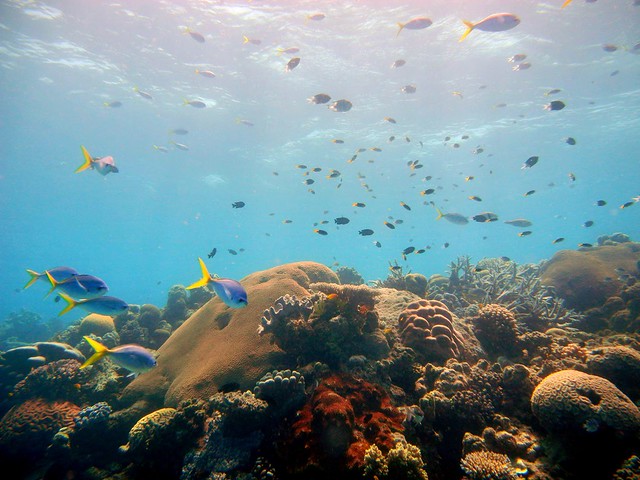


沒有留言:
張貼留言